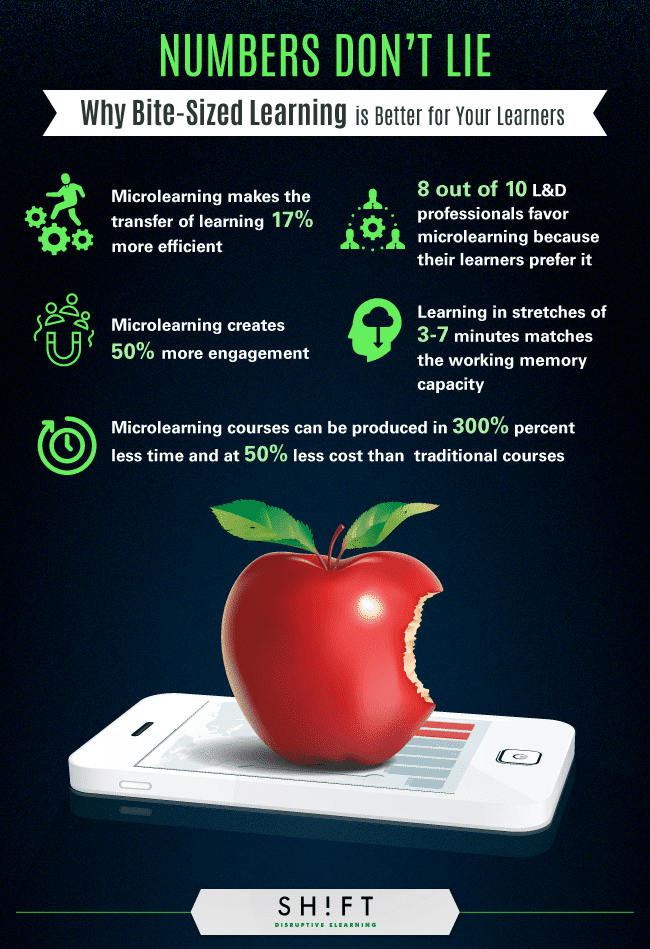Why Has Microlearning Become “a Thing” and Will it Last?

Along with attention spans getting shorter, there is a growing need for alternative ways of learning that are as far away from traditional learning as possible. Learners expect to learn more, in less time, and microlearning has proven to be the way they can do that. It’s been proven that when learning is bite-sized, it is more easily consumed and makes for better knowledge retention.
The features of microlearning that make it what is ̶ fun and playful ̶ may make it hard to be taken seriously, or be considered as an exclusive method of learning. As a result, this might make one think it as just a trend that won’t last, but up until now, microlearning has defied that.
Let’s explore what it’s all about!
What is Microlearning?
Microlearning is every YouTube or Ted-Ed video you’ve watched and learned from. Easily said, it was made to adjust to the needs of the modern learner.
It is a learning method which delivers content in small units to help learners tackle a large volume of learning content by taking small chunks at a time. These chunks can be 5 or 10-minute video lessons, or a number of short lessons on one certain learning objective given to the learner – you guessed it – in chunks.
Microlearning content is designed for quick consumption on any device, especially on mobile devices since they are used the most, and they usually target a very specific need. Therefore, if you learned something from a tweet you read on your feed, then that counts as microlearning too. You might not have learned a whole new area ̶ that would be macro-learning and it would’ve taken you much more time ̶ but you still learned something, even though it was from a 280-character paragraph.
Continuous learning is a great solution for better knowledge retention, and microlearning is the perfect method of instruction, taking into account the fact that employees have less than 25 minutes per week to actually stop and learn. This makes microlearning the solution for corporate training. When one thinks of it as dull and boring, but it doesn’t have to be so; microlearning helps spice things up with concise, fun, easy-to-grasp content!
Perfect for today’s fast-paced world
Microlearning is perfectly suited for today’s fast-paced world. It is the answer for people with hectic schedules because it addresses their needs, motivation, and style of learning.
From the instructor’s perspective, it is quick to develop, and from the learner’s perspective, it is easily accessible whenever they need it.
How to have effective microlearning
All learning assets must be highly focused on delivering the one solution they were looking for. The materials should be accessible for the learner from whatever device they happen to be using at that time, which is usually their smartphone. And the content should be targeted directly at their specific situation so that it is relevant and helpful to them.
And finally, in order for it to be effective, microlearning needs to be available when the learner needs it most, which is always right now.

Benefits of microlearning in employee training
Microlearning is the complete opposite of traditional employee training. Instead of making your employees attend a five-hour face-to-face training session to learn a new business concept or to welcome new hires, in which they only listen and are not engaged, microlearning teaches them what they need to know step by step, bite by bite, piece by piece.
It is one of the newest technology trends shaping eLearning and it doesn’t plan on going anywhere. Here are eight ways microlearning benefits employee training:
- Simple but focused, smaller segments but precise information.
- Can be produced quickly, which results in lower costs than traditional eLearning.
- Microlearning is 50% more interactive and engaging to learners.
- It is accessible just in time, and on the go.
- It makes the transfer of learning 17% more efficient.
- It can be applied for formal learning or as a Performance Support Tool.
- Bite-sized learning content can be updated quickly to enhance their impact.
- Learning in 3- to 7-minute stretches matches the working memory capacity.
Drawbacks of microlearning in employee training
Learning is not a one-size-fits-all type of thing, and microlearning will not suit every learner. So, before making the decision to include microlearning in your Learning and Development strategy, keep in mind these notable, somewhat negative, aspects:
- Microlearning covers only one learning objective.
- Microlearning usually doesn’t work with highly technical content. There’s only so much simplifying you can do!
- Microlearning can be distracting. Too much fun can distract from actual learning, so self-discipline is needed.
- Microlearning simply can’t do it all alone. Other forms of training have to exist for maximum efficiency.
Therefore, while it offers a great solution for learning enthusiasts that are always short on time, if we speak about corporate training, microlearning has to be part of a well-designed L&D strategy to be successful. However, microlearning offers a great learner-centered learning solution for just-in-time learning support that grabs the learner’s attention, and much more. Its benefits are so numerous that, according to our expectations, it will, indeed, last.
Article contributed by Eloise Peterson
Exclusively for knowbly.com
